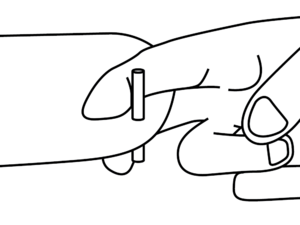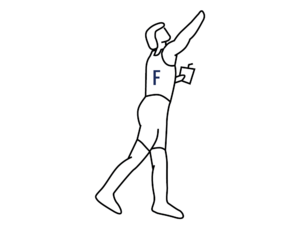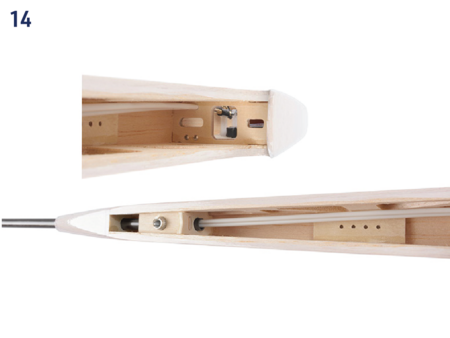KAVAN Cumul DLG ARF 1096mm - Bauanleitung
Einführung
Vorsichtsmaßnahmen
Dieses RC-Modell ist kein Spielzeug. Benutzen Sie es mit Vorsicht und befolgen Sie die Anweisungen in dieser Anleitung genau.
Sie sich an die Anweisungen in dieser Anleitung. Bauen Sie das Modell gemäß der Anleitung zusammen. Modifizieren und verändern Sie das Modell nicht. Bei Nichteinhaltung erlischt die Garantie. Folgen Sie der Anleitung um ein sicheres und haltbares Modell nach dem Zusammenbau zu erhalten.
Kinder unter 14 Jahren müssen das Modell unter Aufsicht eines Erwachsenen betreiben.
Versichern Sie sich vor jedem Flug, dass das Modell in einwandfreiem Zustand ist, dass alles einwandfrei funktioniert und das Modell unbeschädigt ist.
Fliegen Sie nur an Tagen mit leichtem Wind und an einem sicheren Platz ohne Hindernisse.
Bauen Sie das Modell genau nach der Anleitung. Ändern Sie oder passen Sie das Modell auf keine Weise an. Sonst riskieren Sie, dass das Modell gefährlich oder unbeherrschbar sein kann. Finden Sie Zeit für den Bau, bauen Sie alles fest und zuverlässig. Benutzen Sie ein entsprechendes RC Set und andere Ausstattung, die im perfekten Zustand ist; installieren Sie richtig alle Teile des Modells und überprüfen Sie ihren Betrieb und Funktionieren vor dem ersten und vor jedem nächsten Flug. Wenn Sie kein erfahrener RC Pilot sind, fliegen Sie nur mit Hilfe eines erfahrenen Modellbauers.
Technische Daten
| Spannweite | 1096 mm |
| Länge | 880 mm |
| Fluggewicht | 180 g |
| Profil | YA 0801 |
| Schwerpunktlage | 65–70 mm |
| Steuerbare Funktionen | Seitenruder, Höhenruder |
Empfohlene Ausstattung
- Höhenruder- und Seitenruderservo: KAVAN GO-6MG 2×
- Akku: 1S LiPo 3,7 V 450–500 mAh
Empfohlene Klebstoffe
Wenn nicht ausdrücklich anders angegeben, kleben Sie die Teile mit einem mittelflüssigen Sekundenkleber (KAV56.9952 KAVAN Power CA mittelflüssig). Verkleben Sie die Festverbindungen (Flügelverbinder usw.) mit einem 30-Minuten-Epoxidkleber (KAV56.9967 Epoxy 30min), der eine hohe Festigkeit aufweist und ausreichend Zeit für die genaue Ausrichtung der Teile bietet.
Werkzeuge und Hilfsmittel
- Sehr scharfes Modellbaumesser mit auswechselbaren Klingen (z.B. Excel 16001 mit Klinge Nr. 11)
- Schere
- Elektrische Bohrmaschine mit Bohrer-Satz
- Schneidezange
- Zange mit flachen, dünnen Backen
- Flach- und Kreuzschraubendreher
- Rasiersäge
- Schleifpapier 180–220, 360–400er Körnung
- Nadelfeilen-Set
- Lötkolben mit Lot
- Modellbau-Stecknadeln
- Stäbchen und kleine Dose zum Epoxidmischen
- Abdeckband, klares Selbstklebeband
- Spiritus (zum Abwischen von überschüssigem Epoxid)
- Papierserviette oder ein sauberes Tuch (zum Abwischen von überschüssigem Epoxid)
- Stahllineal
- Rechtwinkliges Dreieck
- Dünne transparente Polyethylen-Folie
- Alkoholmarker mit dünner Spitze
- Schmelzkleberpistole + Schmelzkleber
Zusammenbau
Flügel
- Bereiten Sie die Halbrippen W1 und W2, den Flügelverbinder W34 und die Flügelbefestigungsschraube-Platte W32 vor. (Abb. 2)
- Reinigen Sie die Kanten aller Teile nach Bedarf, überprüfen Sie, ob sich der Flügelverbinder W34 leicht in die Gehäuse in beiden Flügelhälften einführen lässt - schleifen Sie den Verbinder nach Bedarf oder verwenden Sie eine Nadelfeile, um den Raum im Flügel vorsichtig zu vergrößern.
- Schneiden Sie mit einem spitzen Modellbaumesser die Abdeckfolie ab, die den Ausschnitt für die Flügelbefestigungsschraube-Platte W32 bedeckt, in der Nähe der Endleiste der beiden Flügelhälften. Schieben Sie die Flügelhälften an den Verbinder, ohne sie zu verkleben. Legen Sie zwischen sie die Halbrippen W1 und W2 ein und in die Aussparung platzieren Sie die Flügelbefestigungsschraube-Platte W32. Die Flügelhälften sichern Sie mit Abdeckbändern und prüfen Sie, ob der überstehende Teil der Halbrippe W1 in das Loch im Rumpf eingeführt werden kann und ob die Position des Lochs in der Platte W32 mit der Position der im Rumpf eingeklebten Befestigungsmutter übereinstimmt. (Abb. 3)
- Wenn Sie zufrieden sind, kleben Sie den Flügelverbinder W34 mit einem 30-Minuten-Epoxidkleber in eine Flügelhälfte und kleben die Halbrippen W1 und W2 auf die Wurzelrippe so, dass ihre Kante um den Umfang mit der Kante der Wurzelrippe übereinstimmt (Abb. 4).
- Legen Sie die Flügelhälfte mit dem eingeklebten Verbinder auf die Tischkante (geschützt mit Kunststofffolie), so dass der Vorsprung W1 über die Tischkante hinausragt und kleben Sie die andere Flügelhälfte mit einem 30-Minuten-Epoxidkleber. Achten Sie darauf, dass die Endleisten der beiden Flügelhälften in der Mitte genau gegenüber liegen. (Abb. 5)
- Kleben Sie die Unterlage für die Flügelbefestigungsschraube-Platte W32 mit einem 30-Minuten-Epoxidkleber ein und bohren Sie nach dem Aushärten des Klebers mit einem 3,2 mm Bohrer ein Loch für die Flügelbefestigungsschraube durch die Halbrippe W2. Zum Schluss überkleben Sie den Verbinder der Flügelhälften mit einem Streifen durchsichtigem Klebeband. (Abb. 6)
- Kleben Sie den Kohlefaserstift für den Schleuderstart in das Loch am linken Ende des Flügels (für Rechtshänder) oder am rechten Ende (für Linkshänder) sorgfältig mit einem Epoxidkleber. (Abb. 7)
Fuselage
- Using a very sharp pointed modeller’s knife, cut the covering film over the opening for the tailplane pylon in the horizontal stabilizer and over control horn slots in the elevator and rudder. Cut the small slots for the Kevlar® thread in the fin - refer to Fig. 9.
- Use a fine needle file to trim the pre-cut slots for the horizontal tailplane pylon, fin and elevator and rudder push rod exits in the carbon tube tail boom. Use a round fine needle file to make a groove for the rudder push rod tube in the tailplane pylon F22. (Fig. 8)
- Insert the tailplane pylon F22 into the tail boom - no glue yet. Insert the fin and rudder assembly into the notch at the end of the tail boom and tack glue it to the tail boom. Bind the fin to the tail boom with a Kevlar® thread threaded through the slots in the fin. (Fig. 9)
- Slide the horizontal stabilizer on the F22 tailplane pylon; align it square to the fin and to the longitudinal axis of the tail boom and tack glue it to the pylon. Double-check the correct alignment; once satisfied, apply a generous amount of cyano along all the joints and onto the Kevlar® thread. Insert the elevator and rudder push rod outer tubes into the tail boom. Secure them with a piece of polyurethane foam soaked with epoxy that you will work into the centre of the tail boom with a thin stick. This is great for a precise, slope free elevator and rudder control. (Fig. 10 + 11)
- The servo mount supplied in the kit has been tailored for the recommended KAVAN GO-6MG servos. Whatever type of servos you are going to use, always check if the openings won’t need a bit of trimming first. We recommend soaking the edges of the servo openings with cyano. Once satisfied, glue the servo mount in place (the servos are to be fitted in the upside-down position). (Fig. 12+13)
- Thread the protruding ends of the elevator and rudder push rod outer tubes through the holes in the rear servo compartment former so the tubes lead directly to the horns of servos in the servo mount. Insert the tail boom into the fuselage - no glue yet. (Fig. 14)
- Attach the wing to the fuselage and secure it with the M4 bolt. Looking from above, front and rear check the fuselage and tail boom are straight and the wing dihedral makes a nice symmetrical "V" in relation to the horizontal stabilizer. Once satisfied cut the push rod outer tubes to the correct length and epoxy thoroughly the tail boom into the fuselage. Double-check the correct alignment before the glue sets.
- Solder the M2 brass threaded couplers on one end of the 0.8 mm piano wire push rods. Screw the ball links on and slide the push rods into the respective outer tubes. Secure the ball links to both two servo arms with the M1.6 screws supplied in the kit. Insert the fibreglass control horns into the slots in the elevator and rudder - do not glue yet. Set the servos to the neutral with your radio on. Attach the servo arms square to the side of the servo case. Set the elevator and rudder flush with the horizontal stabilizer resp. fin. Mark the correct length of the push rods and bend them to the right angle (you can make a "Z-bend", but the simple L-bend usually works well enough). Insert the L-bends into the holes in the control horns and cyano the horns into the elevator and the rudder still set in the neutral position. Finally, secure the servos with drops of hot melt glue, silicone or MS polymer glue in the servo tray. (Fig. 15+10+11)
- Glue the F14 locking plate to the front of the servo & battery compartment hatch; the locking plate has to match the position of a notch in the fuselage side reinforcement plate; the hatch has to match the opening in the fuselage side. Epoxy the pair of magnets F15 into the hatch and fuselage. Double-check their polarity - they have to cling to each other! For easy removal, apply a strip of folded sticky tape to the rear edge of the hatch. (Fig. 16+17)
- Install your receiver into the fuselage under the wing; the receiver battery will go into the nose.
Tow hook
- Install the tow hook in the plywood tow hook plate - drill through one of the pre-drilled holes using a 3.0mm drill bit. It should be positioned about 5 mm in front of the centre of gravity. (Fig. 18)
Recommended control surface throw, CG position
- CG Position: 69–72 mm (Fig. 19)
- Rudder: ±25 mm
- Elevator: ±10 mm
- Discus launch configuration: rudder -1 mm against the direction of the launch (right-handed - rudder 1 mm right), elevator 1 mm down.
Flying
Be sure you are using fully charged batteries. Now (and before any further flight again) check the correct function of the whole radio equipment, motor and moving of control surfaces. Be sure any part of flight equipment cannot move during flight. We strongly recommend making a range check (see your radio instruction manual for details).
The first flight: Wait for a calm day. Fly only on a safe site such as an RC club flying field. Glider will be very happy on your favourite slope on a calm day. The very light lift will allow perfect fine trimming out.
Switch your transmitter and then the receiver on and check all the working systems one more time. Facing INTO the wind hold your transmitter in one hand; grip the model in the other hand near the centre of gravity. Hold it at head level and give the model a fairly powerful push exactly into the wind; wings level, nose slightly down. Your model should now glide in a long, flat and straight path without needing any help from you. Use the controls gently if necessary, and adjust the trim tabs until your CUMUL DLG glides above the described way. Now check the position of control surfaces; set the length of pushrods to bring back trim tabs on your transmitter to a central position if necessary (we strongly recommend doing it in any way). Check again the gliding of your CUMUL DLG.
Now you are ready to make your first discus launch.

Discus Launch
The discus launch allows your model to reach quite a high altitude without much effort. As it is with any "sports performance", it will require some training to do it right – our step-by-step manual makes it easy. We will describe the procedure for a right-handed pilot; with the launching pin attached to the left wingtip. The "left-handed" procedure is the mirror image.

Position A - getting ready:
Your right index finger and middle finger should be wrapped around the launch pin at the left wing tip. Your thumb is to be gently pressed against the leading edge of the wing. Stand with your left shoulder into the wind and the right wing tip pointing at ca 45° angle to the ground.

Position B - the first step:
Take a long step with your left foot pulling the CUMUL DLG up and forward with your right arm.

Position C - rotation:
Start rotating to the left keeping the CUMUL DLG flat and your right arm extended.

Position D – continued rotation:
The second half of the rotation - the part that is most important for a good launch. Do not use too much arm in this section. Just let the swing of your torso speed the CUMUL DLG up.

Position E - release:
By this time in the launch the plane will be trying to climb on its own. Just release your fingers and let the plane fly out of your hand directly into the wind.

Position F – taking control:
Catch your balance. Watch your CUMUL DLG climb whilst getting hold of your radio and be ready to control your model. The plane will climb after release – the climb angle should be shallow at first. Once you are well acquainted with the discus launch you can use more force and increase the launch angle up to 60–80 degrees. When completely familiar and comfortable you can add two quick steps before starting the turning sequence to get some extra speed and energy.
When the plane has slowed almost to the point of stopping push full down elevator to achieve level flight. When this is done at the right moment the plane will go into horizontal flight with just enough airspeed to maintain a gentle glide. If it is done too early the plane will pitch up her nose dangerously after a short dive. If it is done too late the plane will stall.
Parts list
| Main parts | |||
|---|---|---|---|
| Part | Quantity | Building plan no. | Material |
| Instruction manual | 1 | ||
| Sheet of stickers | 1 | ||
| Pushrod set | 2 | Plastic tube + 0.8 mm piano wire | |
| Tail boom | 1 | Carbon tube Ø6/5 mm | |
| Left wing panel | 1 | ||
| Right wing panel | 1 | ||
| Horizontal tailplane | 1 | ||
| Fin & rudder | 1 | ||
| Bag no. 1 - small parts | |||
| Tow hook | 1 | Metal | |
| Magnet Ø3 mm | 2 | F15 | Neodymium |
| Wing bolt M4 | 1 | Nylon | |
| Rudder horn | 2 | Fibreglass 1.5 mm | |
| Ball link short M2 | 2 | ||
| Threaded coupler M2 | 2 | Brass M2/0.8 mm | |
| Rudder and elevator servo tray | 1 | F12 | Balsa 4 mm |
| Carbon pin | 1 | Ø5 mm | |
| Fuselage hatch lock | 1 | F14 | Lite Ply 3 mm |
| Wing riblet | 1 | W2 | Lite Ply 3 mm |
| Wing riblet | 1 | W1 | Plywood 3 mm |
| Wing joiner | 1 | W34 | Plywood 3 mm |
| Wing bolt plate | 1 | W32 | Plywood 2 mm |
| Tailplane pylon | 1 | F22 | Lite Ply 3 mm |
| Kevlar thread | 1 | ||



















